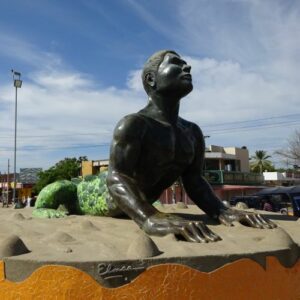
El Hombre Caimán : The Alligator Man
| Description | |
|---|---|
| Origin | Columbia |
| Classification | Cryptid |
| Demeanour | Neutral |
| Habitat | Lake |
| Status | Not Proved |

Introduction
In the heart of Colombian folklore lies a tale that is both haunting and deeply symbolic—El Hombre Caimán. Emerging from the riverside town of Plato, in the Magdalena department, this legend weaves together themes of curiosity, punishment, and transformation. Rooted in the oral traditions of the Caribbean coast, the story follows Saúl Montenegro, a man whose voyeuristic intentions led him down a supernatural path with irreversible consequences. More than just a scary story, the tale serves as a moral lesson and a cultural icon that continues to live on in festivals, songs, and storytelling.
Physical Attributes
El Hombre Caimán is often described as an unsettling fusion of man and reptile. His most distinguishing feature is his human head, which stands in stark contrast to his large, scaly alligator body. The dual nature of his form captures the grotesque results of tampering with natural boundaries. Locals say his human expression never fades, even as his powerful tail and armored limbs move silently through the water. This grotesque juxtaposition turns him into a figure of both horror and pity—caught in an eternal struggle between his original self and his monstrous form.
First Sighting/Reporting
The first whispers of El Hombre Caimán began circulating in the 1940s, when stories emerged in the coastal city of Barranquilla. Though the original newspapers like La Prensa are no longer in circulation and no physical clippings survive, the story quickly spread through oral retellings across river communities. These early reports described a strange creature seen swimming in the Magdalena River—an alligator with a man’s face. The legend grew from these sightings and became entrenched in local consciousness as more people claimed to spot the mysterious hybrid gliding through the murky waters.
Other Names
Though best known as El Hombre Caimán, the character has taken on other titles over the years. He is sometimes referred to as El Lagarto (The Lizard), especially in rural versions of the tale. In theatrical adaptations and popular comedy, the name has become a cultural nickname, even serving as the moniker for Colombian comedian Álvaro Lemmon, who helped popularize the story nationally. Regardless of the name, each version underscores the same transformation and the cautionary nature of the tale.
Modus Operandi
The legend centers around Saúl Montenegro, whose fascination with women bathing in the river drove him to a dangerous decision. Wanting to observe without detection, he visited a local shaman who provided two magical potions—one red to turn into a caiman, and one white to revert to human form. For a time, his scheme worked. He would transform, spy, and return unharmed. But one day, his trusted companion was absent, and the replacement panicked, spilling the white potion. Only Saúl’s head returned to human form, leaving the rest of his body trapped as a reptile. From then on, fear spread through the town. Women avoided the river, and fishermen took to the waters with weapons, hoping to rid themselves of the monster. His mother, the only person who still recognized him, would bring food to the riverbank until her death. After that, Saúl—the half-man, half-caiman—disappeared into the Magdalena, destined to wander alone.
Pop Culture References
El Hombre Caimán is far more than a local ghost story; he is a symbol of regional identity and creativity. In Plato, a monument honoring the creature stands proudly, serving as a constant reminder of the story’s impact. Every year, the town hosts the Festival del Hombre Caimán, a lively event filled with parades, music, theatrical re-enactments, and traditional dances. The legend also inspired one of Colombia’s most famous folk songs, “Se Va el Caimán” by José María Peñaranda, which cemented the myth in popular music. Comedians, authors, and musicians continue to reference the story, demonstrating its lasting grip on the cultural imagination.
Current Status
Though decades have passed since the legend first surfaced, the myth of El Hombre Caimán is still alive in Colombia—especially along the Magdalena River. Locals in fishing villages occasionally claim to see odd ripples in the water or spot an unusual shape beneath the surface. The monument in Plato attracts both tourists and believers, and the festival continues to grow each year, keeping the tradition vibrant. Whether viewed as a myth, moral lesson, or supernatural reality, the story continues to be told around dinner tables and campfires, preserving the cultural soul of the region.
Source
Contributors to Wikimedia projects. (n.d.). El Hombre Caimán – Wikipedia. https://en.wikipedia.org/wiki/El_Hombre_Caim%C3%A1n
Hombre Caiman – Explore Mythology – Gods and Monsters. (n.d.). https://godsandmonsters.info/hombre-caiman/
Hombre Caiman – Monstropedia. (2022). https://www.monstropedia.org/index.php?title=Hombre_Caiman
Hombre Caiman | Fact | FactRepublic.com. (n.d.). https://factrepublic.com/facts/32130/









